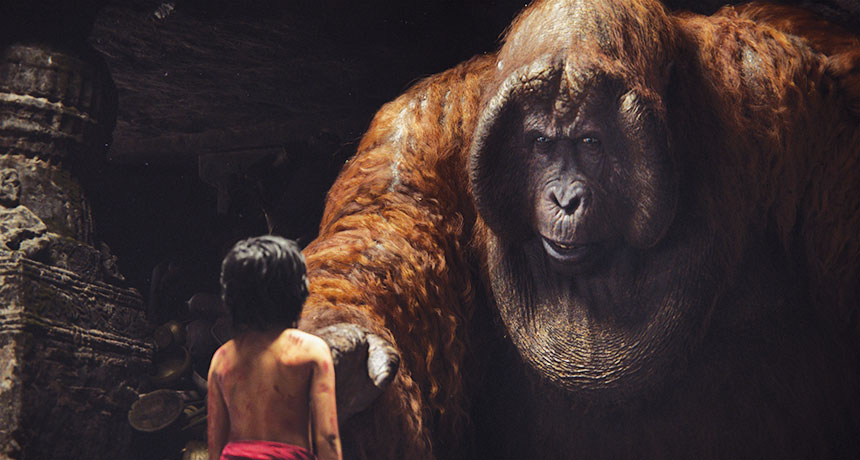Disney’s ‘The Jungle Book’ resurrects giant extinct ape

In the 1967 animated Disney film The Jungle Book, the feral boy Mowgli encounters a jazz-singing orangutan named King Louie, who implores Mowgli to teach him the secret of fire. King Louie presented a challenge for the producers of Disney’s live-action, CGI-enhanced remake of the film, opening April 15. “We had this notion that we would be as authentic as we could be to the region,” says producer Brigham Taylor. The problem: Orangutans are not native to India.
In fact, King Louie himself is not native to Rudyard Kipling’s original stories. But instead of scrapping the character, the filmmakers got creative. While researching India’s wildlife, the film’s art department learned that a colossal ape named Gigantopithecus once roamed the region. Various species of Gigantopithecus lived in India, China and Southeast Asia from about 6.5 million years ago until as recently as a few hundred thousand years ago. The ape was truly gigantic — by some estimates, twice as big as a gorilla.
So King Louie morphed from orangutan to Gigantopithecus. The switch was a “fun justification,” Taylor says, to keep the character and play up his size while still staying true to India’s fauna. (Yes, the ape is extinct, but this is a movie about talking animals. And fossil evidence does suggest that the ape at least mingled with the human ancestor Homo erectus.)
Using the scientific information they could find on the Internet, visual effects artists imagined how the animal would look and move, Taylor says. The result: an ape that resembles an overgrown orangutan, Gigantopithecus’ closest living relative. The movie ape has shaggy hair, flaring cheeks and a saggy pouch that hangs from the throat like a double chin — and towers about 12 feet tall.
It’s difficult to judge how accurate Disney’s rendering is. Despite possibly having been the largest primate ever to have lived, Gigantopithecus
left behind few fossils. Scientists have just four lower jaws and over a thousand teeth, says biological anthropologist Russell Ciochon of the University of Iowa. That’s not much to go on, but Ciochon and colleagues made their own reconstruction a couple decades ago.
The researchers took a jaw from China and made an outline of a skull that could fit such a jaw. Because most primate skulls scale to body size, Ciochon says, his group could estimate Gigantopithecus’ weight, 800 to 900 pounds, and height, about 9 feet from head to toe. (The species that lived in India was actually probably smaller.) Adding other details like hair to the animal is a matter of conjecture, Ciochon says.
But the teeth do offer some solid details about the ape’s lifestyle. Wear patterns and microscopic debris stuck to the teeth indicate Gigantopithecus dined on fruits, leaves, shoots, roots and perhaps even bamboo. Last year, researchers confirmed those details after analyzing the ratios of carbon isotopes in teeth found in Southeast Asia. The analysis also determined that Gigantopithecus was a strict forest dweller, even though it also lived near grasslands in some areas. In fact, the researchers contend, Gigantopithecus’ reliance on forests and its big size — and therefore big appetite — may have been the animal’s undoing. As Southeast Asia’s jungles gave way to expanding grasslands during the last glacial period, Gigantopithecus may have been unable to cope.
Perhaps if our ancestors had shared the secret of fire with Gigantopithecus, the giant ape would still be around today.